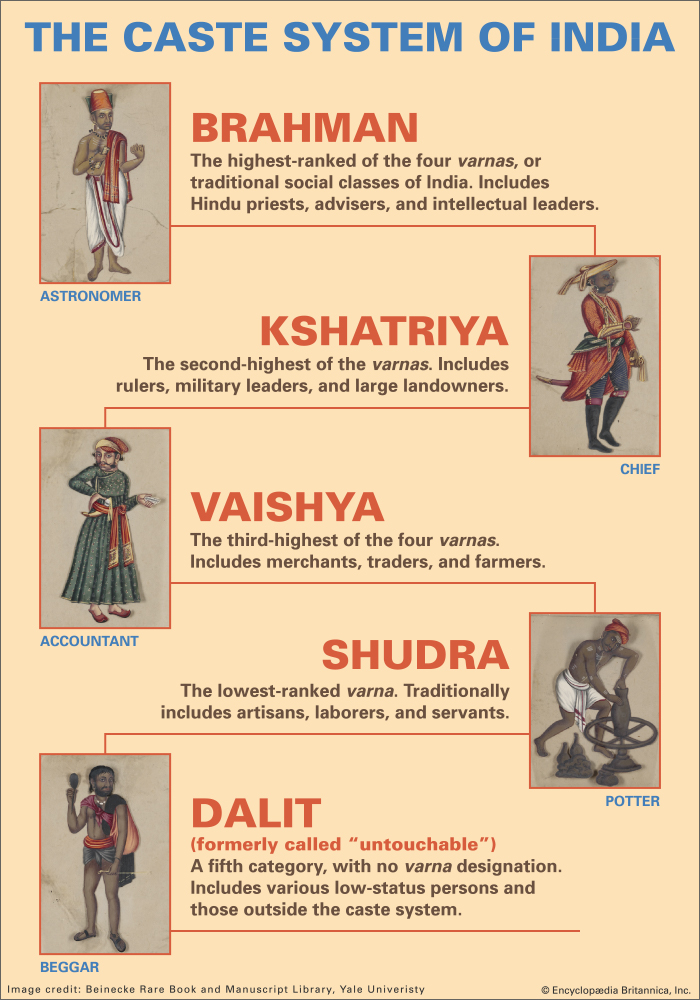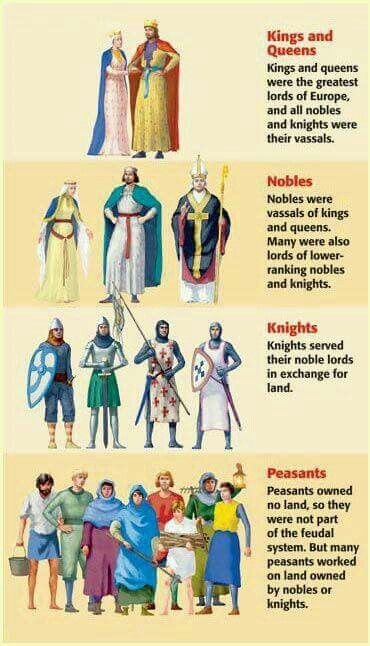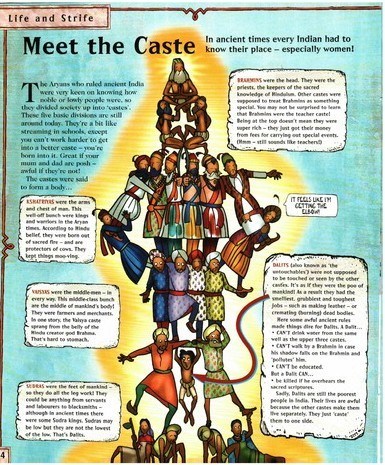

The Aryans that invaded the Indo-Pak Subcontinent had the fear that if no action was taken, they being in minority would be overwhelmed by the local people. Also, they being of noble extraction would be assimilated with the natives and thus would lose their Aryan identity. They had, therefore, to create a fortress of social institution, a regime of apartheid.
Humans are by nature suffering from the “us and them” syndrome. It has given birth to the caste system leading to people’s stratification in a society based on the notion of a section being pure and the other polluted. Various factors are at play in creating this phenomenon, like economic and financial position, profession, race, descent, place of origin etc. Such a differentiation among the people is generally endogamous and hereditary, and so the stigma continues for generation after generation resulting in such evils as hatred, discrimination, maltreatment, exclusion, segregation, and servitude.
Many countries have seen such groups of outcastes like Japan’s Burakumin, Korea’s Baekjeong, Yemen’s Akhdam, Nigeria’s Osu, Somalia’s Madhiban/Yibir/ Tumal, and Kenya’s Watta. This class is generally required to perform dirty works like scavenging and to live in designated areas separate from the living quarters of the high caste people.
Millions and millions of people around the world are suffering from this apartheid. Such a caste system is man-made and, therefore, has either been done away with through legislation or has lost its intensity with the changes in time, norms of society, and economic and social status of the victim.
In this regard the caste system of Hinduism is unique. Though it is also man-made yet it has been buttressed with the sanctity of religion. Thus, it has been used to structure the life of a Hindu from birth to death, even to his next birth irrespective of the place where he is born or lives. Being made as one of the chief pillars of Hindu society and religion, it is persisting tenaciously even to this day. An orthodox follower of this religion holds that the caste system is of divine appointment and that it has existed for all time. According to them, this philosophy springs out of the person of the Divinity himself. The tenth and final “book” of the Rig Veda (X.90), explains in the hymn, ‘Sacrifice of the Cosmic Man” (Purusha-sukta): “Into how many portions did they divide this being whom they immolated? What did his mouth become? What are his arms, his thighs, and his feet now called? His mouth became Brahmana, his arm was made Rajanya; his thigh was transformed into Vaiśy; from his feet sprang Śudra”. Such a classification of human beings that claimed to be universal and divine is not, however, acceptable to the world or to any other religion. The origin of this man-made system is political, and religious sanction has been given to it merely to sustain it.

The invading Aryans in the Indo-Pak Subcontinent had the fear that if no action was taken, they being in minority would be overwhelmed by the local people. Also, they being of noble extraction would be assimilated with the natives and thus would lose their Aryan identity. They had, therefore, to create a fortress of social institution, a regime of apartheid. The institution that emerged in this way was based on the most obvious mark of distinction between the Aryans and the local people: the color of skin. The equivalent word for ‘covering’ in their language was varna. So, the natives were declared to be belonging to different varna, thus keeping the dark-skinned native population segregated from themselves. They now belonged to new varna, to that of Sudras. This division of society on the basis of color was eventually to become so deep-rooted in the Aryan culture that varna was translated later into an ultra-rigid caste system.
When the Aryans had begun their lives in India, they were already divided into three social classes: the warriors, the priests, and the commoners, which reflected more of professions. Caste consciousness had not yet developed, as is clear from the remarks such as “A bard am I; my father is a leech and my mother grinds corn”. Unable to eliminate the natives, they planned to absorb them into the Aryan society but only at the lowest level. The locals were thus declared a separate people, to a caste belonging to a lower birth, the Sudra, completely different from the new ruling nation. In this way, the Aryan political and social ascendancy was complete. It was a regime of apartheid that allowed the lowest caste to acquire only menial professions and to serve the higher caste people. Categorization of human beings through the caste system can be understood only this worldly way, and which is specific to the Hindu society.
Human beings, on the other hand, maybe classified based on race, which brands people according to their origin to a certain region, or having a different body structure, or typical facial features, or a different color of the skin. However, it is not imaginable that a group of people, who are born in the same place with similar physical features and skin color, can be different from each other based on caste. Therefore, this classification can only be deemed as arbitrary, without any visible physical evidence. After all, what is a caste? It cannot be defined except through Hinduism’s imaginary concept of the people’s divine birth. Further, Hinduism cannot explain the caste of those who are not born a Hindu or are born in different places throughout the world. A principle that is unable to define itself in universal terms is thus not sustainable, hence superfluous. According to E.J Rapson, the broad distinction between conquerors and conquered is no doubt natural and universal. With the change of time, such man-made social barriers have been either weakened or done away with in other societies, but they have remained firmly ingrained in India, which means that human institutions have received the sanction of a religion that has been concerned more with the preservation of social order than with the advancement of mankind.
Hindu religion maintains that all living beings have an immortal soul. They have been made to believe that the quality of actions (karma) of a person during his lifetime determines the status in which he would take rebirth with this eternal soul. Thus, the soul has to pass through a succession of lives and deaths, until it achieves liberation (moksha). The underlined fatalism that one’s own karma of the previous life is responsible for his present state or caste into which he is born forces him to accept unquestionably his status in society. This religious sanction was so sacred that even with later political and social advancement no government could dare adopt measures for its eradication in order to enforce equality among citizens. On the contrary, they subordinated their policies to the exigencies of society. The present Constitution of India, however, prohibits its application, but religion, legend, tradition, and illiteracy have such a strong grip on the masses that it has not been able to make much of a difference.

Strangely, while the institution of caste is totally absent in Islam, the followers of this religion, who are mostly the local converts, living together with the Hindus in India since the early eighth century also could not separate themselves from this Vedic embrace. Today the Muslims of the Indo- Pak Subcontinent belong to various castes, higher or lower, by descent, race, and profession, like Syed, Sheikh, Malik, Pathan, Jat, Kunjra (vegetable seller), Qasab (butcher), and Julaha (cloth weaver). It has created somehow a sort of social segregation among the Muslims, most notably in the sphere of inter-marriages. In the footsteps of the Brahmans, the highest caste of the Hindus, the Muslims too should have one. Since Islam has no Cosmic Man, the person of the Holy Prophet was available there for their help; his descendant became Syed. The rest were considered not of such noble origin, although Islam says that the most preferable before God are only those who are pious. The Prophet’s admonition for the differentiation between the Ajams and Arabs, and between blacks and whites, was thrown to the winds.
Hinduism is not a revealed religion. It has no set doctrine and is such a composite of varied beliefs that it belies easy definition. It has no church or hierarchy of priests, nor congregational set-up of any sort. The main factor that is detrimental in affecting reforms from within is the absence of an authoritative body that could assess the needs of the society from time to time and make pronouncements. The caste system is not a small component of the faith; rather it has encompassed the entire structure of Hinduism. Necessarily, very gigantic and revolutionary steps were needed for its reform. Also, the measures to bring change in this institution might not be taken in the short run; they had to be evolved and the society to be conditioned for it over a long period of time. However, the initiative never came forth in this direction from the people of intellect, learning, and high position who alone could bring a change. Unfortunately, they were the high caste people and were themselves the beneficiary of this arrangement. The scourge of the caste system thus persists. Hinduism does not allow any dent in the system irrespective of the change in the financial position and social status of the individual. For example, even if the President of India is a Dalit, he would remain an individual of low caste, an untouchable, and would not be permitted, on religious principles, to enter the temples of the high caste Hindus.
_______________________
The above article was shared by Mr. Osman Sher via Jan – a forum of intellectuals, writers, editors and academicians as part of the discussion on Cisco Caste Discrimination Case in California, USA. Mr. Scott R. Stroud, Ph.D. Associate Professor of Communication Studies; Program Director of Media Ethics, Center for Media Engagement; Past President, American Society for the History of Rhetoric; Editor, Media Ethics and Knight Faculty Fellow had shared the Caste Discrimination Court Case via Jan.
Ambedkar International Center (AIC) Inc. has filed an Amicus Brief in Cisco Caste Discrimination Case in California, USA and the hearing has been set on March 9.
This brief would help the court rule on Cisco’s motions by shedding light on the nature of caste discrimination. As the brief makes clear, caste is hereditary, and casteism is therefore a form of ancestry discrimination forbidden by the California Fair Employment and Housing Act (FEHA). Casteism is also a form of race and color discrimination.
Ambedkar International Center is dedicated to understanding and disseminating the ideas of Dr. B. R. Ambedkar, who fought to eradicate caste discrimination and make Indian society more just. AIC is joined in this filing by the organizations and scholars whose names appear at the end of the brief.
Click on American workplaces must be caste-free zones to read the Brief